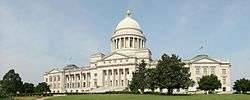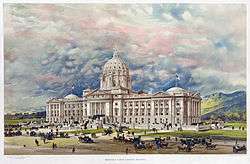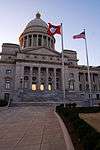Arkansas State Capitol
| Arkansas State Capitol | |
|---|---|
 Main façade of the Arkansas State Capitol | |
| General information | |
| Architectural style | American neoclassicism |
| Address | 500 Woodlane Street |
| Town or city | Little Rock, Arkansas |
| Country | United States |
| Construction started | November 27, 1900 |
| Completed | January 1, 1915 |
| Cost | US$2,200,000 |
| Client | State Capitol Commission |
| Owner | Arkansas government |
| Design and construction | |
| Architect | George R. Mann |
| Main contractor | Caldwell & Drake |
| Website | |
|
sos | |
|
Arkansas State Capitol | |
 Location within Arkansas | |
| Coordinates | 34°44′48.26″N 92°17′21.2″W / 34.7467389°N 92.289222°WCoordinates: 34°44′48.26″N 92°17′21.2″W / 34.7467389°N 92.289222°W |
| NRHP reference # | 74000494 |
| Added to NRHP | June 28, 1974 |
The Arkansas State Capitol, often called the Capitol Building, is the home of the Arkansas General Assembly, and the seat of the Arkansas state government. It sits atop Capitol Hill at the eastern end of the Capitol Mall in Little Rock, Arkansas.
History
In 1899, the St. Louis architect George R. Mann visited the governor of Arkansas Daniel W. Jones, and presented his drawings of his winning competition design from 1896 for the Montana State Capitol, which had not yet been built in their state capital of Helena. They were hung on the walls of the old Capitol to generate interest in a new building. The drawings' attractiveness eased the passage of the appropriation bills for the new building, and also drew attention to the architect. In 1899, Mann was selected as architect by a seven-member commission that included future governor George W. Donaghey. Donaghey opposed Mann's selection and advocated a national design competition, but the majority of the commission voted for Mann.[1] After Donaghey was elected governor in 1908, he forced Mann off the project and selected Cass Gilbert to finish the Capitol.[2]
Construction took 16 years, from 1899 to 1915. The Capitol was built on the site of the state penitentiary and prisoners helped construct the building. They lived in a dormitory that was left on the Capitol grounds while construction was taking place.
The Capitol foundations were aligned incorrectly by their original builder, future Governor George Donaghey. He centered the building on the centerline of Fifth Street (now Capitol Avenue), but he aligned the building north-south using the still-standing penitentiary walls as a guide without recognizing that Fifth Street was not aligned east-west; like other "east-west" downtown Little Rock streets, it runs parallel to the Arkansas River at a slight angle off true east-west. Therefore, the structure is in a north-south manner from end-to-end, which does not fit the grid street pattern of Little Rock's downtown. This also led to a slight S-curve in the formal entrance walkway between the foot of Capitol Avenue and the front steps of the Capitol.
In Popular Culture
As a smaller scale replica of the United States Capitol in Washington, D.C., the State Capitol has frequently been used as a filming location. In 1990, the Arkansas Capitol grounds were featured extensively in external and internal photography for the action film Stone Cold starring Brian Bosworth.
It was also used in the background as sixth President John Quincy Adams (Anthony Hopkins) walked around the outside supposedly in the early 1840s in the film Amistad (1997) about a famous mutiny aboard a captured slave ship and the prisoners U.S. Supreme Court case to gain their freedom.
Architecture
The exterior of the Capitol is made of limestone, which was quarried in Batesville, Arkansas.[3] Though it was initially stipulated a total cost for the envisioned capitol would not to exceed $1 million dollars, total construction cost eventually was $2.2 million (or $320 million in 2014 dollars). The front entrance doors are made of bronze, which are 10 feet (3 metres) tall, four inches (10 cm) thick and were purchased from Tiffany & Company in New York for $10,000. The cupola/dome is covered in 24 karat gold leaf. The government was formerly located in the Old State House. The structure also used Yule marble.
Monuments and memorials
The Arkansas State Capitol grounds has multiple monuments and memorials representing various parts of the state's past and present. They include the Monument to Confederate Soldiers, Liberty Bell replica, Bauxite and Granite Boulders, Confederate War Prisoners Memorial, Law Enforcement Officers Memorial, Vietnam Veterans Memorial, Arkansas Medal of Honor Memorial, Memorial Fountain, Monument to Confederate Women, and "Little Rock Nine" Civil Rights Memorial.
 The winning competition design was from 1896 for the planned Montana State Capitol in Helena by George R. Mann, became the model for the Arkansas State Capitol.
The winning competition design was from 1896 for the planned Montana State Capitol in Helena by George R. Mann, became the model for the Arkansas State Capitol. The entrance to the State Capitol
The entrance to the State Capitol Interior view of the Arkansas State Capitol Dome looking up from the Rotunda.
Interior view of the Arkansas State Capitol Dome looking up from the Rotunda. Monument to Confederate Women May 1, 1913 The statue was designed by J. Otto Schweizer, The monument was added to the National Register of Historic Places in 1996.
Monument to Confederate Women May 1, 1913 The statue was designed by J. Otto Schweizer, The monument was added to the National Register of Historic Places in 1996. "Little Rock Nine" civil rights memorial commemorating desegregation of Central High School in Little Rock in 1957 on Capitol grounds
"Little Rock Nine" civil rights memorial commemorating desegregation of Central High School in Little Rock in 1957 on Capitol grounds
See also
References
- ↑ The Encyclopedia of Arkansas History & Culture: George Richard Mann (1856–1939), retrieved 3 March 2010
- ↑ The Cass Gilbert Society, retrieved 4 July 2012
- ↑ Stone Used in the Construction of the Arkansas State Capitol Building, retrieved 4 July 2012
External links
- Government
- General information

- Arkansas State Capitol at the Encyclopedia of Arkansas History & Culture
